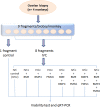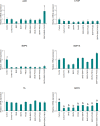Short-term culture of ovarian cortical strips from capuchin monkeys (Sapajus apella): a morphological, viability, and molecular study of preantral follicular development in vitro
- PMID: 23314959
- PMCID: PMC3713647
- DOI: 10.1177/1933719112472737
Short-term culture of ovarian cortical strips from capuchin monkeys (Sapajus apella): a morphological, viability, and molecular study of preantral follicular development in vitro
Abstract
The aim of this study was to evaluate whether an in vitro culture (IVC) medium containing either or not β-mercaptoethanol (BME), bone morphogenetic protein 4 (BMP4), or pregnant mare serum gonadotrophin (PMSG) could be able to promote the development of capuchin monkeys' preantral follicles enclosed in ovarian cortical strips. Follicular viability after IVC was similar to control (89.32%). Primordial follicle recruitment to primary stage was not reached with IVC, but the rate of secondary follicle formation was increased in the medium supplemented with BME, BMP4, and PMSG (44.86%) when compared to IVC control (9.20%). In the medium supplemented with BME, BMP4, and PMSG, contrary to other media, anti-müllerian hormone-messenger RNA (mRNA) expression in ovarian tissue was upregulated (3.4-fold), while that of growth differentiation factor-9 was maintained. The BMP4-mRNA expression, however, appeared downregulated in all cultured tissues. Our findings show a favorable effect of BME, BMP4, and PMSG on the in vitro development of secondary follicles from capuchin monkeys.
Keywords: growth factors; nonhuman primates; qRT-PCR; viability.
Conflict of interest statement
Figures




References
-
- Hearn J. New world primates for research in human reproductive health. Am J Primatol. 1994;34(1):11–17. - PubMed
-
- Figueiredo JR, Rodrigues APR, Silva JRV, et al. Cryopreservation and in vitro culture of caprine preantral follicles. Reprod Fertil Dev. 2011;23(1):40–47. - PubMed
-
- Domingues SFS, Caldas-Bussiere MC, Petretski MDA, et al. Effects of follicular phase and oocyte-cumulus complexes quality on the protein profile and in vitro oocyte meiosis competence in Cebus apella. Fertil Steril. 2010;93(5):1662–1667. - PubMed
-
- Hovatta O, Silye R, Abir R, et al. Extracellular matrix improves survival of both stored and fresh human primordial and primary ovarian follicles in long-term culture. Hum Reprod. 1997;12(5):1032–1036. - PubMed
-
- McLaughlin M, Telfer EE. Oocyte development in bovine primordial follicles is promoted by activin and FSH within a two-step serum-free culture system. Reproduction. 2010;139(6):971–978. - PubMed
Publication types
MeSH terms
Substances
LinkOut - more resources
Full Text Sources
Other Literature Sources

